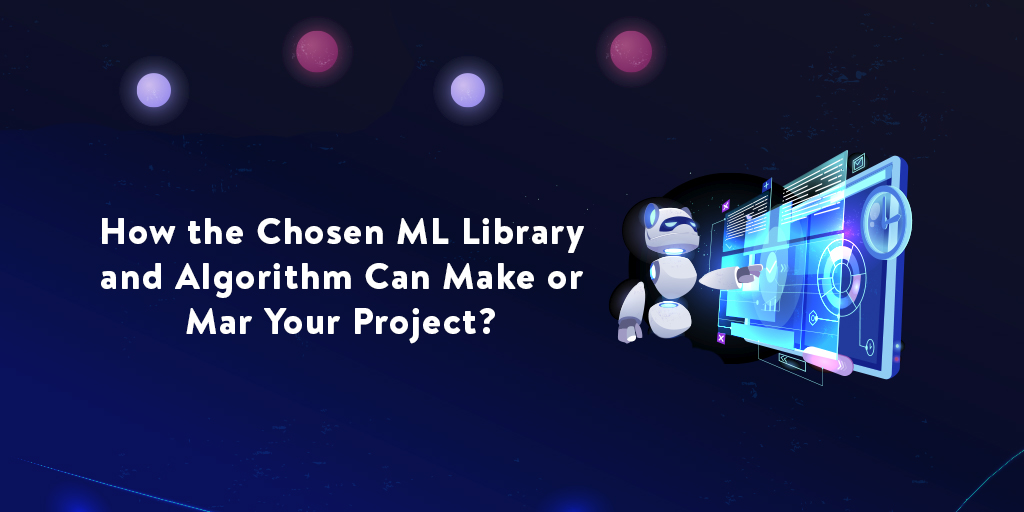Machine learning (ML) is the ability of computers to discover or learn patterns from the data available and imitate the same. Data patterns help the machines learn and derive similar conclusions, on their own. For the successful use of machine learning, machines need lots of data. If there is enough data available, the ML results are accurate. So, the performance of ML improves with time.
The simplest example for machine learning or ML is the autosuggest (autocomplete) feature on Gmail that guides us by suggesting common phrases to complete our statements while drafting an email.
Today, machine learning finds its use in numerous industries to include healthcare, farming, transcription, manufacturing, and many more. ML is also helping businesses understand the market through machine-learning-aided tools offering in-depth data analytics and assists in enhancing the customer experience.
What Are Machine Learning Libraries and Algorithms?
Libraries are a set of routines and functions. ML libraries are a collection or set of machine learning and data mining algorithms that extract and utilize the data for various purposes or applications. These provide different ready algorithms and mathematical and statistical formulae to reduce coding efforts.
ML algorithms are a set of procedures that specify the way data is transformed and utilized by the machine to learn and produce the desired output in the ML project.
ML libraries help reduce your work as you can leave a lot of machine learning and deep learning calculations and operations on the library and focus on the complexities. The way different programming-language libraries serve different purposes, so do ML algorithms and libraries.
Each library has a different set of functions or features that collectively define the way it will extract, analyze, and utilize the data for machine learning. There are multiple libraries (and algorithms within these) available, both open-source and paid. Having a good understanding of these libraries can greatly help ML developers. You need to choose the right ML algorithm and library for your project based on what features suit your requirements the most!
Which Are the Most Popular ML Libraries?
- NumPy is the ML library particularly useful for complex mathematical functions like linear algebra and random number capabilities. It can also perform scientific computations. NumPy is widely used in ML applications meant to handle sound waves, images, and other binary functions.
- SciPy has different modules for numerical integration, interpolation, optimization, linear algebra, and statistics. It is very useful for image manipulation. It is also easy to understand and has fast computational powers and is thus one of the most popular core ML libraries.
- Scikit-learn is a Python-based ML library for working with classical ML algorithms. It builds on the basic libraries NumPy and SciPy. Scikit-learn is commonly used for data mining and data analysis. It covers a wide range of clustering, regression, and classification algorithms. It is a popular choice in artificial intelligence projects for advanced probability modeling and unsupervised classification and clustering.
- TensorFlow from Google, again a Python-based library, is widely used in deep learning research and application. Its performance in this area is trusted and well-known due to the fact that Google itself makes use of the TensorFlow ML library in its image and voice recognition applications.
- Theano (Python) is a scientific computing library used to define, optimize, and evaluate mathematical expressions. It helps reduce development time and boost execution time in deep learning algorithms.
Why Is It Important to Choose the Right ML Algorithm and Library to Ensure the Success of Your Project?
Choosing the right library and algorithm for your ML project is crucial for the success of the project. The ML algorithm chosen can create wonders for your project or damage the complete purpose of the project. So, development firms face a big challenge in selecting the right algorithm for the ML project in hand. It is good to experiment on multiple libraries and algorithms and decide based on the results.
The choice of an ML algorithm is a crucial decision for the project. As different ML algorithms handle the data differently, choosing the wrong algorithm may not satisfy your project needs. For example, a crop grows well in a particular soil condition. The same crop may not grow that well in another soil while another crop would grow amazingly in this soil-type.
So, here are some algorithm parameters for selecting the right algorithm for your ML project.
1. Supervised Learning
Based on the data available and the results needed, algorithms can be supervised learning or unsupervised learning algorithms. In supervised learning algorithms, we humans provide specific labeled data to the computer that contains the predictors and show it the desired results or the correct answers too, to learn the pattern. In short, the algorithm predicts, is corrected by the teacher, again predicts till the desired output is achieved. These algorithms are used where the ML project’s target input data and desired output are both specific and labeled. For example, SVM, Decision Trees, Random Forest, and Linear Regression. An example of supervised learning is predicting the weather based on past records for a particular location and separating spam emails in your inbox based on rules set for classification.
2. Unsupervised Learning
In unsupervised learning algorithms, the data is not labeled or specific. This is for projects where we do not know what specific data or inputs are to be taken from the data sample. Here the computer or the machine itself needs to learn and then derive conclusions. The algorithm does the task of detecting patterns and deriving rules based on the results and insights obtained. For example, k-means.
3. Speed
Some algorithms are speedy. Definitely, high-speed results compromise on accuracy. Every project has different levels of precision required. So, speedy-result algorithms are used where the ML project requires less precision, speedy output.
4. Accuracy
When your ML project requires very accurate results, you need to opt for algorithms that offer the advantage of accuracy though these may not be speedy.
A Case in Point
A smart development team can combine its knowledge and experience to select the right ML algorithm and library for the project. So, it is important to work with the right development partner for your project, else your project may not give the desired results or will fail to satisfy the purpose.
“We must all face the choice between what is right and what is easy.” (By J.K. Rowling)
This quote explains the point so well!
We at Blue Whale Apps understand that the chosen ML library and algorithm can decide the future of your project; it can make or break the story. This is what happened to one of our clients for their ML project.
The Challenge
A medical healthcare company approached us with a problem in their ML project.
The project’s main requirement was to discover (sense) and record human gestures with high precision. The challenge here was to detect, differentiate, and demarcate specific “smoking” gestures from other similar (non-smoking) human gestures to include drinking, eating, shaving, etc.
The Solution
While the popular belief suggested otherwise, our ML experts leveraged their knowledge and experience to successfully capture the right ML algorithm and library. Our testing revealed that the random forest algorithm and TensorFlow library perfectly suit the project needs. TensorFlow library works well for image and voice recognition due to its great performance in classification, perception, discovery, creation, and prediction.
Conclusion
In summary, our team at Blue Whale Apps solved the challenge of selecting and utilizing the right ML algorithm and library for recording and demarcating specific human gestures accurately for our client. Have a thought-provoking project in mind? Discuss with us and we will be glad to help!









